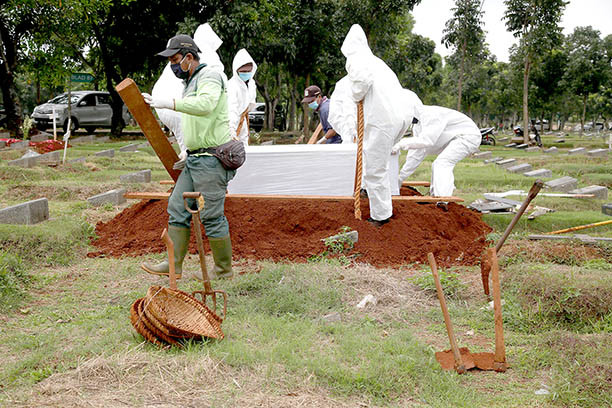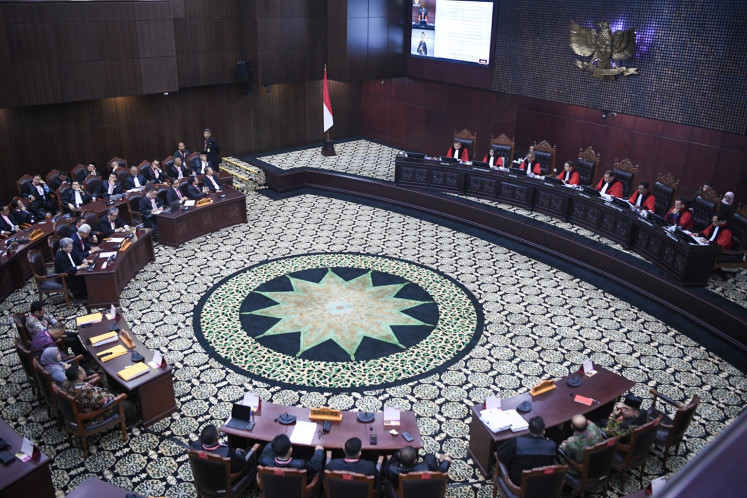The bigger threat the better in pandemic
Unsurprisingly, many Indonesians are not taking the pandemic seriously.
Change Size
 Double burial: Public cemetery officials bury a COVID-19 victim at Pondok Ranggon public cemetery in East Jakarta
on Friday. The cemetery has applied a double burial policy because it has no space left. (JP/P.J. Leo)
Double burial: Public cemetery officials bury a COVID-19 victim at Pondok Ranggon public cemetery in East Jakarta
on Friday. The cemetery has applied a double burial policy because it has no space left. (JP/P.J. Leo)
A
lthough there has been an increase in COVID-19 cases, Indonesians may be content with the new health minister, Budi Gunadi Sadikin, as he has established a better scientifically based approach to testing and tracing.
"The test should target ‘suspected’ persons, not someone who wants to travel, or, like Budi Sadikin, who is to meet the President,” Budi said, claiming that he took five swab tests a week, each as part of protocols to enter the Presidential Palace.
He recently likened the pandemic to World War I and II, as both claimed millions of lives. The ministry has therefore adopted a surveillance strategy through prudent testing and tracing, and aiming to vaccinate more than 181 million Indonesians within one year.
“This is a war and we have to annihilate the enemy. That’s why we involve the police and military. They do not brandish guns but syringes,” Budi told the media.
Although Budi is not a physician, his managerial experience at various national banks has sparked new hope for many, especially medical workers to whom he has shown his sympathy for their hard work. He does not belittle threats of COVID-19 either, unlike his predecessor. Perhaps Budi aims to replicate the methods in place and successful in Singapore and New Zealand.
The government announced the first two confirmed cases of COVID-19 on March 2, 2020, although epidemiologists had seen it coming in January and warned the government of it.
President Joko “Jokowi” Widodo admitted that the government had deliberately hid some information so as to not create panic among the nation’s 270 million people. This reminds us of then-United States president Donald Trump, who chose to cover up the real number of Americans contracting the virus.
After almost a year into the pandemic and 34,691 dead (as per Feb. 23) in Indonesia, what has often featured in government communications is the high recovery rate. Unsurprisingly, many Indonesians have not taken the pandemic seriously.
From the beginning, however, the reliability of the government’s data has been questionable, so the point that it could not form the basis of an accurate epidemiological curve. Luckily Budi has acknowledged the problematic data and promised to fix it.
The data discrepancy may have resulted in an underreported mortality rate. What interests us is the fact that Jakarta applies a different standard for calculating the number of deaths.
In the capital city, the mortality number is divided into two categories. The first includes those who died with positive swab test results. This is the data that has always been reported to the central government.
But Jakarta has also counted all bodies laid to rest under COVID-19 procedures, regardless of whether tests had been performed. The reason is that the cause of death was similar or related to COVID-19 symptoms. No wonder the number is higher than that reported to the central government.
Rationally, this approach provides more accurate data as the foundation of policies and COVID-19 response. It also gives the Jakarta administration and its residents a sense of readiness.
Jakarta is not alone in this regard. The Economist (Sept. 26, 2020) reported that in many countries, the number of deaths and confirmed cases were undercounted. One way to prove the practice is finding what is called the “excess mortality” rate by comparing the number of deaths in 2020 to the predicted mortality number.
Between March and August 2020, countries in Western Europe, some Latin America nations, the United States, Russia and South Africa documented 580,000 COVID-19 deaths but there were 900,000 excess deaths. This means that the true toll of their share of the pandemic appears to have been 55 percent higher than the official data.
While such an approach, which shows the magnitude of the threats and risks of the pandemic, may create panic rather than calm, it prompts society to respond to the crisis more seriously and therefore strictly comply with the health protocols.
From the viewpoint of crisis communication, such a strategy has proven to be more effective in dealing with any threat of risk. Communication expert Kim Witte (2001) explained how the threat could be a good way to generate proactive, healthy and protective actions by those who received the message of risk.
We can argue that to persuade people to act, it is suggested that messages should be given so that people are aware of threats and strengthen their self-efficacy to act in mitigating threats. When people think that the threat is low, they will not respond to the message. However, when someone perceives a serious threat, they will usually be motivated to take action.
Witte said the greater the threat in one perception and the more sensitive a person is to the threat, the more likely they are to take action to avoid the negative feeling about their fear.
That’s why epidemiologist Syahrizal Syarif has suggested that the government adopt stricter measures. Learning from the Jakarta case, micro-level quarantines in place need revision. The University of Indonesia scholar opined that COVID-19 cases in Jakarta and other regions could not be controlled without implementing a lockdown or regional quarantine for 28 days (tempo.co Feb. 9).
With the positivity rate reaching 20 percent, many people who have been infected are not traced and they may have transmitted the virus to the surrounding communities. The micro-level quarantines come too late and there is no guarantee they will work properly.
***
The writer is a medical doctor and lecturer at the Institute for Communication and Business LSPR, Jakarta.









